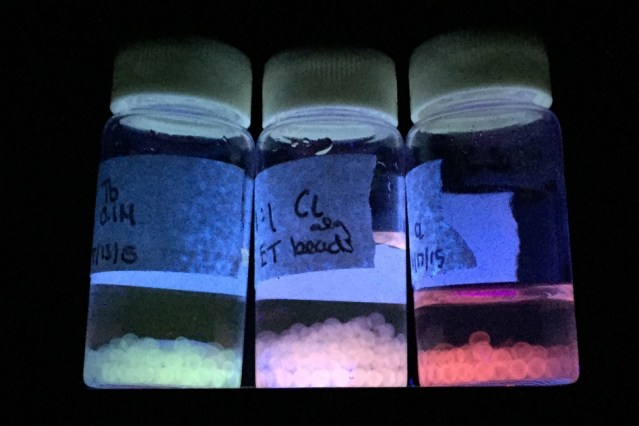A research team at MIT has created a new group of materials capable of emitting light of precisely controlled colours, including pure white light.
 Luminescent materials produced by the MIT team are shown under ultraviolet light, emitting different colors of light that can be modified by their environmental conditions. These light-emitting beads were made by materials science and engineering students Caroline Liu and Rebecca Gallivan. Photo: Tara Fadenrecht
Luminescent materials produced by the MIT team are shown under ultraviolet light, emitting different colors of light that can be modified by their environmental conditions. These light-emitting beads were made by materials science and engineering students Caroline Liu and Rebecca Gallivan. Photo: Tara Fadenrecht
The light output can be controlled in response to a number of external parameters. Potential applications of these materials include detection of thermal and mechanical conditions, or biological and chemical compounds.
Niels Holten-Andersen – an assistant professor of materials science and engineering, postdoc Pangkuan Chen, and two graduate students – Scott Grindy and Qiaochu Li, made up the research team. They have described the material in a paper published in the Journal of the American Chemical Society as a metallic polymer gel that is composed of rare-earth elements.
Chemical tuning of the material, which is essentially a light-emitting lanthanide metallogel, enables it to respond to mechanical, thermal, or chemical stimuli. The presence of specific conditions or substances is shown in the form of a visible output.
The new material is an example of work with biologically inspired materials, Holten-Andersen explains. “My niche is biomimetics — using nature’s tricks to design bio-inspired polymers,” he says. There are an amazing variety of “really funky” organisms in the oceans, he says, adding: “We’ve barely scratched the surface of trying to understand how they’re put together, from a chemical and mechanical standpoint.”
Studying these natural materials, evolved over millions of years to adapt to challenging environmental conditions, “allows us as engineers to derive design principles” that can be applied to other kinds of materials, he adds.
Other research by Holten-Andersen focussed on a specific type of cross linking that occurred in the threads of mussels when they stick to rocks; this type of linking was termed as metal-coordination bonds. He explains that these bonds are crucial for a number of biological functions, like the manner in which oxygen attaches itself to haemoglobin in the red blood cells.
However, he pointed out that this research was not aimed at mimicking nature, but was intended to comprehend and apply the basic principles of natural materials. These principles are also applicable for synthetic materials that have a simpler structure, and are easier to fabricate than equivalent materials in nature.
For the fabrication of the material, a metal from the lanthadides group, or the rare-earth elements, was combined with polyethylene glycol (PEG), which is a commonly used polymer. The resulting material was capable of emitting multicoloured, tunable light. The emitted light showed sensitivity to minute changes in environment; this sensitivity was shown in the form of a colour-coded output that was in tune with external conditions.
“It’s super-sensitive to external parameters,” Holten-Andersen says. “Whatever you do will change the bond dynamics, which will change the color.”
For instance, the material could be developed to identify the presence of specific toxins, pollutants, or pathogens, through a visible change in the emitted color.
Apart from chemical detection, the material could also be used for detecting mechanical changes like stresses in mechanical systems. According to Holten-Andersen, this method of detection could be particularly useful in measuring forces in fluids, which are otherwise difficult to measure due to the subtleness of forces.
The various forms in which the material can be made into are coatings or thin film or gel. It can be applied on structures for detecting a potential failure, much before it actually occurs.
Holten-Andersen published his research on metal-coordination bonds in polymers as a separate paper in the journal 'Nature Materials' on the 31st of August. In the paper, he provided details on making polymers that exhibit tunable mechanical properties, like stiffness. The paper also mentioned that such materials are naturally self-healing and self-assembling, and find potential applications as energy-absorbing materials or in biological implants capable of absorbing impact without breaking.
“What’s nice here is that the materials change color in response to such a wide and rich set of stimuli,” says Stephen Craig, a professor of chemistry at Duke University who was not involved in this research. He adds, “The fact that the reference state can be made white is quite useful; it’s often easier to detect by eye that something has a faint shade of green, for example, than that it is one shade of green as opposed to another.”
Craig sees a variety of potential uses for such materials. “I can imagine using these or similar materials as in situ monitors of a wide range of conditions,” he says, adding that practical deployment of the technology could be facilitated by the fact that “the core hydrogel scaffold used here is so prevalent in studies of both biological and fundamental polymer physics questions.”
The research was funded by the MIT Sea Grant through the Doherty Professorship in Ocean Utilization, and the MIT Energy Initiative